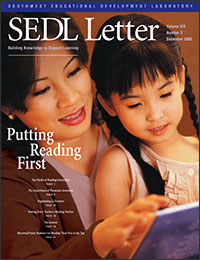Appropriate Reading Assessments Are a Click Away with SEDL's Database
A New Mexico principal tells the story of an American Indian kindergarten student at his school. When shown pictures of four common objects during an assessment of early reading skills, the child described the objects vividly without ever using the names of the objects. That the child was able to do so may have reflected the powerful oral tradition of his native language, Keres, and his fluency in that language. But, according to Southwest Educational Development Laboratory (SEDL) program specialist Sebastian Wren, it may also have been a reflection of a poor assessment tool or one not suitable for that particular student.
Wren notes that while there are a variety of early reading assessments available, many are poor or inappropriate assessments. "Some don't support the cognitive elements related to learning to read," he explains, such as phonology, syntax, or phoneme awareness."Many measure skill levels completely unrelated to reading—for example, one assessment measures fine motor skills. "He notes others measure skills that research has shown are not critical to learning to read, such as rhyming.
‘The first step in improving reading instruction and increasing achievement is to find out what kids know and don't know. That means assessing kids on a number of cognitive elements, including comprehension, phoneme awareness, syntax, and decoding," says Joan Buttram, SEDL executive vice president and chief operating officer.
SEDL's database meets regional and national needs
To guide educators and technical assistance providers in their search for appropriate assessments, SEDL developed the Reading Assessment Database for Grades K–2, found online at http://www.sedl.org/reading/rad.
The database includes information about more than 150 assessments designed for young students. It offers essential information to educators deciding whether to use an assessment, including its cost, how it is administered, cognitive elements supported by the assessment, and languages in which the assessment can be administered.
Debbie Smith, director of reading and literacy at the Oklahoma State Department of Education reports her office used the database when they created Oklahoma's "State Approved Reading Sufficiency Assessment List," which is part of Oklahoma's Reading Sufficiency legislation. "The database was so helpful, because we had to choose assessments for K–3 and designate the specific areas that it assessed. Specifically, we looked at phoneme awareness, phonics, spelling, fluency, and comprehension," she says. "We asked all of our eligible districts who were writing a Reading Excellence Act grant to utilize the database when addressing the assessment portion of the grant. In addition, we have a link for SEDL and the database from our state Web site."
Throughout the country, hundreds of educators, state agencies, and technical assistance providers are using SEDL's Reading Assessment Database on an ongoing basis—the site averages 3,000 hits each month.
Knowing how and what to teach to strengthen reading
The searchable database is just one of the many research-based tools and strategies being used in SEDL's systemic work with schools and districts across the southwest region. As part of its Regional Educational Laboratory contract, SEDL and its partner, the Charles A. Dana Center, are building the capacity of schools and districts to improve performance in reading and mathematics. Most of the schools with which SEDL and the Dana Center are working have chosen to focus on strengthening reading instruction as their first step in raising student achievement.
In the REL site work, SEDL staff are helping schools become more effective reading teachers by providing them with a background of the cognitive development that takes place as children learn to read, using The Cognitive Foundations of Learning to Read: A Framework. The framework was developed during the last REL contract, along with a collection of tools to help teachers acquire the expertise to strengthen instruction, administer assessments effectively, and se data to inform their instruction. Each school's progress will be measured by progress made on state achievement tests.
SEDL's Reading Assessment Database and Cognitive Foundations Framework work hand-in-hand to help schools increase reading achievement. "It is no surprise that the most effective teachers have a sound understanding of the relationship between assessment and instruction," says Buttram. "They have the ability to assess students' needs and are able to meet those needs with focused instruction that directly addresses the areas." As one reading support specialist recently reported to SEDL via e-mail, "We have a commitment to good assessment at my school, and to serving kids' diagnosed needs as best we can, so the database is a very helpful source for finding what we need. Our data shows good growth for our students over the past two years, and the right assessments have helped us know what to teach."
Next Article: Credits

